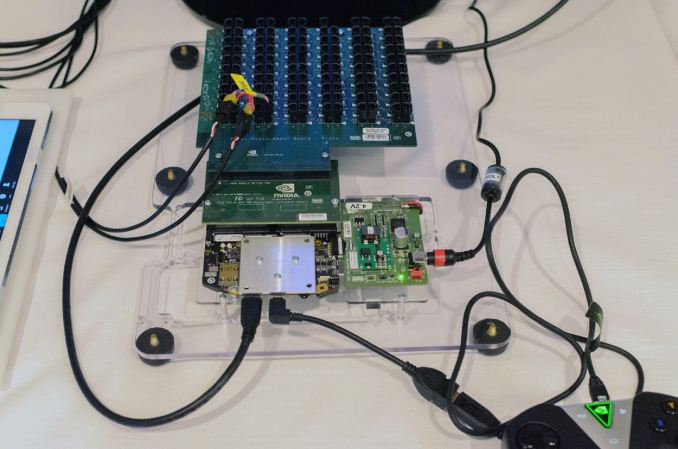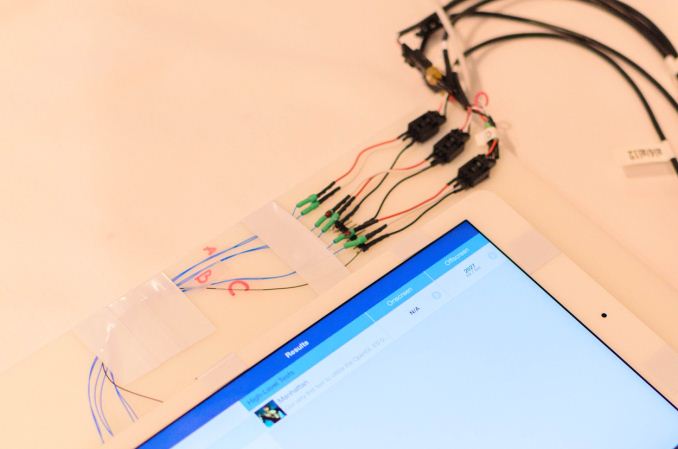NVIDIA Tegra X1 Preview & Architecture Analysis
by Joshua Ho & Ryan Smith on January 5, 2015 1:00 AM EST- Posted in
- SoCs
- Arm
- Project Denver
- Mobile
- 20nm
- GPUs
- Tablets
- NVIDIA
- Cortex A57
- Tegra X1
GPU Performance Benchmarks
As part of today’s announcement of the Tegra X1, NVIDIA also gave us a short opportunity to benchmark the X1 reference platform under controlled circumstances. In this case NVIDIA had several reference platforms plugged in and running, pre-loaded with various benchmark applications. The reference platforms themselves had a simple heatspreader mounted on them, intended to replicate the ~5W heat dissipation capabilities of a tablet.
The purpose of this demonstration was two-fold. First to showcase that X1 was up and running and capable of NVIDIA’s promised features. The second reason was to showcase the strong GPU performance of the platform. Meanwhile NVIDIA also had an iPad Air 2 on hand for power testing, running Apple’s latest and greatest SoC, the A8X. NVIDIA has made it clear that they consider Apple the SoC manufacturer to beat right now, as A8X’s PowerVR GX6850 GPU is the fastest among the currently shipping SoCs.
It goes without saying that the results should be taken with an appropriate grain of salt until we can get Tegra X1 back to our labs. However we have seen all of the testing first-hand and as best as we can tell NVIDIA’s tests were sincere.
| NVIDIA Tegra X1 Controlled Benchmarks | |||||
| Benchmark | A8X (AT) | K1 (AT) | X1 (NV) | ||
| BaseMark X 1.1 Dunes (Offscreen) | 40.2fps | 36.3fps | 56.9fps | ||
| 3DMark 1.2 Unlimited (Graphics Score) | 31781 | 36688 | 58448 | ||
| GFXBench 3.0 Manhattan 1080p (Offscreen) | 32.6fps | 31.7fps | 63.6fps | ||
For benchmarking NVIDIA had BaseMark X 1.1, 3DMark Unlimited 1.2 and GFXBench 3.0 up and running. Our X1 numbers come from the benchmarks we ran as part of NVIDIA’s controlled test, meanwhile the A8X and K1 numbers come from our Mobile Bench.
NVIDIA’s stated goal with X1 is to (roughly) double K1’s GPU performance, and while these controlled benchmarks for the most part don’t make it quite that far, X1 is still a significant improvement over K1. NVIDIA does meet their goal under Manhattan, where performance is almost exactly doubled, meanwhile 3DMark and BaseMark X increased by 59% and 56% respectively.
Finally, for power testing NVIDIA had an X1 reference platform and an iPad Air 2 rigged to measure the power consumption from the devices’ respective GPU power rails. The purpose of this test was to showcase that thanks to X1’s energy optimizations that X1 is capable of delivering the same GPU performance as the A8X GPU while drawing significantly less power; in other words that X1’s GPU is more efficient than A8X’s GX6850. Now to be clear here these are just GPU power measurements and not total platform power measurements, so this won’t account for CPU differences (e.g. A57 versus Enhanced Cyclone) or the power impact of LPDDR4.
Top: Tegra X1 Reference Platform. Bottom: iPad Air 2
For power testing NVIDIA ran Manhattan 1080p (offscreen) with X1’s GPU underclocked to match the performance of the A8X at roughly 33fps. Pictured below are the average power consumption (in watts) for the X1 and A8X respectively.
NVIDIA’s tools show the X1’s GPU averages 1.51W over the run of Manhattan. Meanwhile the A8X’s GPU averages 2.67W, over a watt more for otherwise equal performance. This test is especially notable since both SoCs are manufactured on the same TSMC 20nm SoC process, which means that any performance differences between the two devices are solely a function of energy efficiency.
There are a number of other variables we’ll ultimately need to take into account here, including clockspeeds, relative die area of the GPU, and total platform power consumption. But assuming NVIDIA’s numbers hold up in final devices, X1’s GPU is looking very good out of the gate – at least when tuned for power over performance.














194 Comments
View All Comments
MrPoletski - Monday, January 26, 2015 - link
I can't help but think the reason that this all happened at all is because of AMD and Mantle.maskofwraith - Monday, March 2, 2015 - link
if OpenGL is FAR outdated and a mess then why are they still supporting it? why dont they try to contribute it to it, to make it better? Wait they cant do that all they need is money. half of the internet runs on opensource.GC2:CS - Monday, January 5, 2015 - link
Why ?They do incredibly well on graphics font.
Mondozai - Monday, January 5, 2015 - link
Everyone who thinks that the X1 is going to crush all the competition is going to get burned once more, just like with K1. OEMs want an integrated solution. Yes, Nvidia has awesome GPU capabilities(duh) but that in of itself isn't enough. Still doesn't have an integrated modem, so the smartphone market is dead on arrival.Tablets have a better shot, but Nvidia is aiming for the car market for a reason. There may be a few one-off devices that they will aim for but overall, this isn't going to be a significant force in the high-end tablet space. S810 has the GPU capability to run 4K smoothly.
Apple's next GPU is going to be a lot better, just like every year. Can Nvidia compete on a 'total system basis'? The answer remains as it has always been: no.
speculatrix - Monday, January 5, 2015 - link
Nvidia have Icera, their own 4G/LTE modem technology, so hopefully NVidia will have a version of the X1 with that integrated, or at least a version with a "glue-less" interconnect to their Icera module.Yojimbo - Tuesday, January 6, 2015 - link
The soft-modem is MIA. NVIDIA has not been going after the smartphone market.Yojimbo - Tuesday, January 6, 2015 - link
NVIDIA has not been pursuing smartphones for a couple years now. What advantage does the Snapdragon 810 have over the Tegra X1 in the high end tablet space? Qualcomm will have to compete based mostly on familiarity of the OEMs with their SOCs, price, and the fact that Samsung is unlikely to choose NVIDIA. If the 810 is available at an earlier date, that also might help them out during that time period.aenews - Saturday, January 24, 2015 - link
The Snapdragon 810 doesn't even come close to matching the graphical prowess of the K1, even though it's just about a whole year newer.The Snapdragon 805 saw little adoption. In tablets, there was the Kindle Fire HDX. That's... one whole design win for tablets. The K1 was in the Shield Tablet and the Nexus 9 (and the Xiaomi MiPad).
harrybadass - Monday, January 5, 2015 - link
by the time the new Imagination7xxx&A9x is released this will already be obsolete.Nvidia is playing catchup.
kron123456789 - Monday, January 5, 2015 - link
Yeah. Exactly the same was said about Tegra K1 and GX6650.